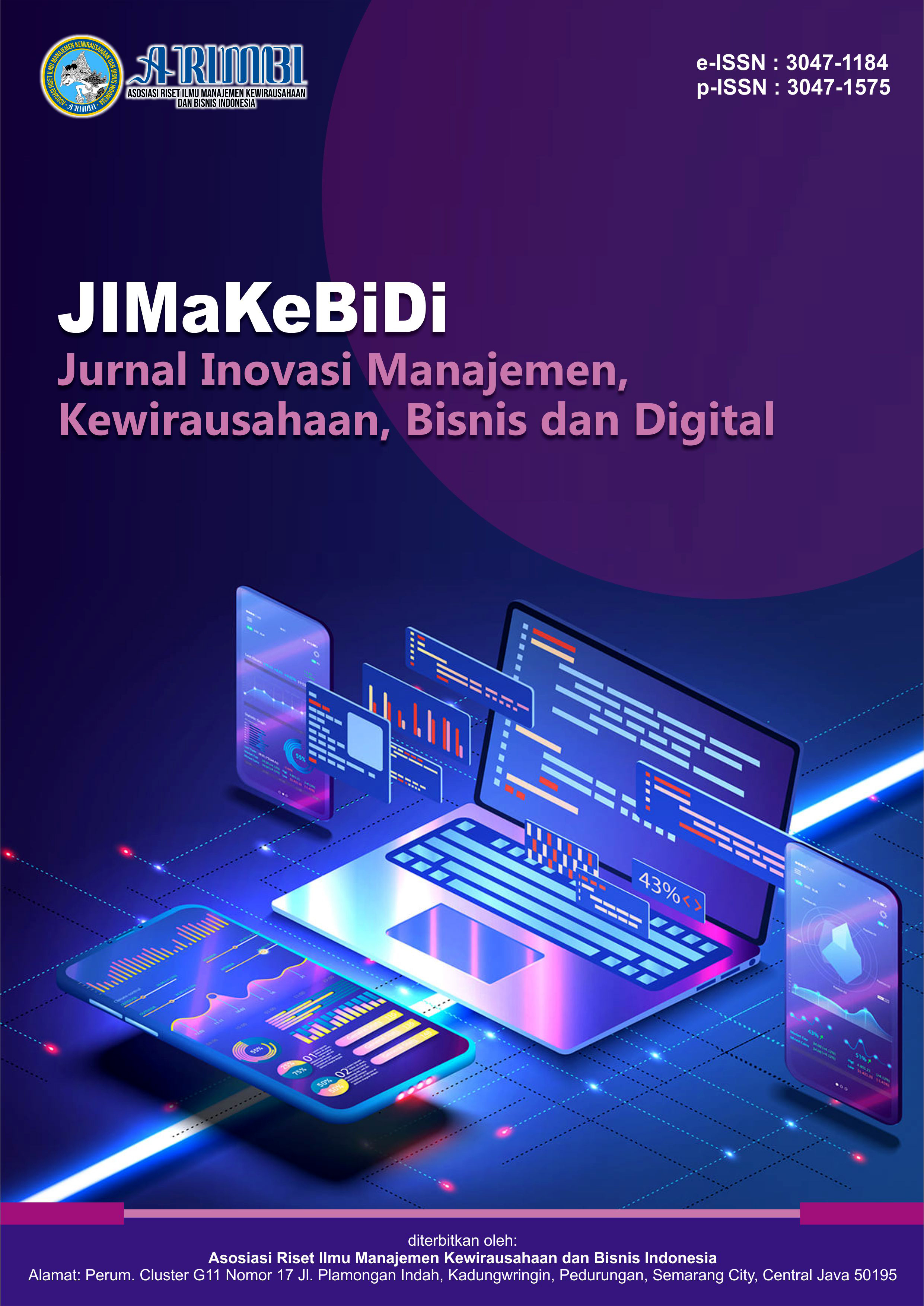Consumer Buying Intention : Food Choice Preferences Based on Cultural Orientation
DOI:
https://doi.org/10.61132/jimakebidi.v2i1.455Keywords:
consumer purchase intention, cultural identity, cultural orientation, food preferenceAbstract
This research investigates consumers’ decisions in buying food preferences in regard to cultural orientation, which shall establish how cultural factors reflect consumers’ decisions on food consumption. Culture orientation includes collectivism, long-term orientation, masculinity and uncertainty avoidance by Hofstede. Using a quantitative research approach, the research employed structured questionnaire surveys that help gain overall view from participants of diversified cultural backgrounds. From 107 respondents of an online survey, key findings reveal that there are significant relationships between culture orientation, i.e., long-term orientation and purchase intention. However, two other culture dimensions of Hofstede do not show association with purchase intention. The findings show that long-term orientation, i.e., long-term benefits are very crucial when they decide to buy their food.
Downloads
References
Adelson, J. L., & McCoach, D. B. (2010). Measuring the mathematical attitudes of elementary students: The effects of a 4-point or 5-point Likert-type scale. Educational and Psychological Measurement, 70(5), 796–807. https://doi.org/10.1177/0013164410366694
Agosto, D. E. (2001). The cultured word: Cultural background, bilingualism, and the school library. School Libraries Worldwide, 7(1), 46–57. https://doi.org/10.29173/slw6768
Al-Adwan, A. S., Alrousan, M. K., Yaseen, H., Alkufahy, A. M., & Alsoud, M. (2022). Boosting online purchase intention in high-uncertainty-avoidance societies: A signaling theory approach. Journal of Open Innovation: Technology, Market, and Complexity, 8(3), 136. https://doi.org/10.3390/joitmc8030136
Ali, F., Rasoolimanesh, S. M., Sarstedt, M., Ringle, C. M., & Ryu, K. (2018). An assessment of the use of partial least squares structural equation modeling (PLS-SEM) in hospitality research. International Journal of Contemporary Hospitality Management, 30(1), 514–538.
Bartkiene, E., Steibliene, V., Adomaitiene, V., Juodeikiene, G., Cernauskas, D., Lele, V., Klupsaite, D., Zadeike, D., Jarutiene, L., & Guiné, R. P. F. (2019). Factors affecting consumer food preferences: Food taste and depression-based evoked emotional expressions with the use of face reading technology. BioMed Research International, 2019, 2097415. https://doi.org/10.1155/2019/209741
Becker, J.-M., Ringle, C. M., Sarstedt, M., & Völckner, F. (2015). How collinearity affects mixture regression results. Marketing Letters, 26(4), 643–659.
Chan, R. Y. (2001). Determinants of Chinese consumers’ green purchase behaviour. Psychology and Marketing, 18(4), 389–413.
Cohen, J., Cohen, P., West, S. G., & Aiken, L. S. (2002). Applied multiple regression/correlation analysis for the behavioral sciences (3rd ed.). Psychology Press.
Fang, Q., Wen, C., & Xu, H. (2024). Long-term oriented culture, performance pressure and corporate innovation: Evidence from China. PLOS ONE, 19(5), e0302148. https://doi.org/10.1371/journal.pone.0302148
Farina, C. F. (2022). The impact of cultural masculinity and femininity on purchase intention. International Journal of Student Education, 1(2), 177–179.
Gudykunst, W. B., & Lee, C. M. (2001). An agenda for studying ethnicity and family communication. Journal of Family Communication, 1(1), 75–85.
Gunawan, S., & Indrianto, A. T. L. (2021). Differences in processing and presentation of Indonesian food in America and Indonesia. Global Research on Tourism Development and Advancement, 3(1), 58–72.
Hafizah, N. (2023). The influence of globalization on Indonesian culture. International Journal of Student Education, 1(2), 177–179.
Henseler, J., Ringle, C. M., & Sarstedt, M. (2015). A new criterion for assessing discriminant validity in variance-based structural equation modeling. Journal of the Academy of Marketing Science, 43(1), 115–135.
Hofstede, G. (2011). Dimensionalizing cultures: The Hofstede model in context. Online Readings in Psychology and Culture, 2(1). https://doi.org/10.9707/2307-0919.1014
Horn, A., & Lee, G. (2016). The reliability and validity of using regression residuals to measure institutional effectiveness in promoting degree completion. Research in Higher Education, 57, 939–947. https://doi.org/10.1007/s11162-015-9394-7
Jeong, S., & Lee, J. (2021). Effects of cultural background on consumer perception and acceptability of foods and drinks: A review of latest cross-cultural studies. Current Opinion in Food Science, 42. https://doi.org/10.1016/j.cofs.2021.07.004
Kashima, Y., Yamaguchi, S., Kim, U., Choi, S. C., Gelfand, M. J., & Yuki, M. (1995). Culture, gender, and self: A perspective from individualism-collectivism research. Journal of Personality and Social Psychology, 69(5), 925–937.
Lam, D., Lee, A., & Mizerski, R. (2009). The effects of cultural values in word-of-mouth communication. Journal of International Marketing, 17(3), 55–70.
Lin, H. F. (2007). Predicting consumer intentions to shop online: An empirical test of competing theories. Electronic Commerce Research and Applications, 6(4), 433–442.
Lindsey, M. (2024). Cross-cultural differences in food preferences and consumption patterns. Journal of Food Sciences, 5, 30–42. https://doi.org/10.47941/jfs.1841
McCarty, J. A., & Shrum, L. J. (2001). The influence of individualism, collectivism, and locus of control on environmental beliefs and behavior. Journal of Public Policy & Marketing, 20(1), 93–104.
Murdoch, M., Simon, A. B., Polusny, M. A., Bangerter, A. K., Grill, J. P., Noorbaloochi, S., & Partin, M. R. (2014). Impact of different privacy conditions and incentives on survey response rate, participant representativeness, and disclosure of sensitive information: A randomized controlled trial. BMC Medical Research Methodology, 14, 90. https://doi.org/10.1186/1471-2288-14-90
Naveenan, R. V., & Vijayakumar, T. (2014). A study on cultural based buying behaviour. International Journal of Marketing Studies, 4, 1–8.
O'Brien, R. M. (2007). A caution regarding rules of thumb for variance inflation factors. Quality & Quantity, 41(5), 673–690. https://doi.org/10.1007/s11135-006-9018-6
Paul, B. (2015). Culture and its influence on nutrition and oral health. Biomedical and Pharmacology Journal. https://doi.org/10.13005/bpj/757
Pavlou, P. A. (2003). Consumer acceptance of electronic commerce: Integrating trust and risk with the technology acceptance model. International Journal of Electronic Commerce, 7(3), 101–134.
Pinna, M. (2020). Do gender identities of femininity and masculinity affect the intention to buy ethical products? Psychology & Marketing, 37. https://doi.org/10.1002/mar.21298
Wijaya, S. (2019). Indonesian food culture mapping: A starter contribution to promote Indonesian culinary tourism. Journal of Ethnic Foods, 6, 1–10. https://doi.org/10.1186/s42779-019-0009-3
Zici, A., Quaye, E. S., Jaravaza, D. C., & Saini, Y. (2021). Luxury purchase intentions: The role of individualism-collectivism, personal values, and value-expressive influence in South Africa. Cogent Psychology, 8(1). https://doi.org/10.1080/23311908.2021.1991728
Downloads
Published
How to Cite
Issue
Section
License
Copyright (c) 2025 Jurnal Inovasi Manajemen, Kewirausahaan, Bisnis dan Digital

This work is licensed under a Creative Commons Attribution-ShareAlike 4.0 International License.





